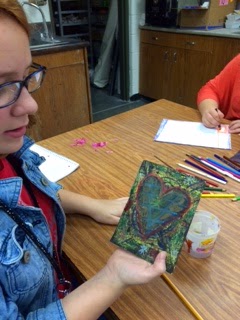One of my favorite things to teach is perspective drawing. I normally would introduce the concepts using mini lessons, introducing the vanishing point and one and then two point perspective. We would draw increasingly difficult house features, interior spaces and monster trucks.
This marking period, I thought I would try to introduce some of the concepts of creating depth on a 2D surface through figuring out how to make optical illusions. We started with making some impossible shape drawings.
We then moved on to playing with the shape of the paper and the cast shadows. We are still novices, but I'm pretty proud of my 6th, 7th and 8th graders attempts.
This activity also slyly introduced the importance of using value to create volume. If we were in class together longer than nine weeks, I would have pushed them a little more in developing that skill.
Hovering basketballs…oooooh
The kids also enjoyed coming up with ways to create disasters. the drawing above is of a students mom's minivan falling through the street. That would be a bad day!
Above: One of the practice drawings we made as a class to learn the basics of perspective as they apply to creating illusions. They loved this one and begged to take it home right away! (I found the example online.)
I think this student is right, UFOs probably did take away all of the bigfoot creatures.
Above: One of the practice drawings we did as a class so they could understand some of the "rules" of creating believable optical illusions. (Also, an example I found online, I didn't really know how they were made myself until I started playing around with it). I think it is important to let your students know you are learning all the time too.
Watch out for never ending portals!











.jpg)



















